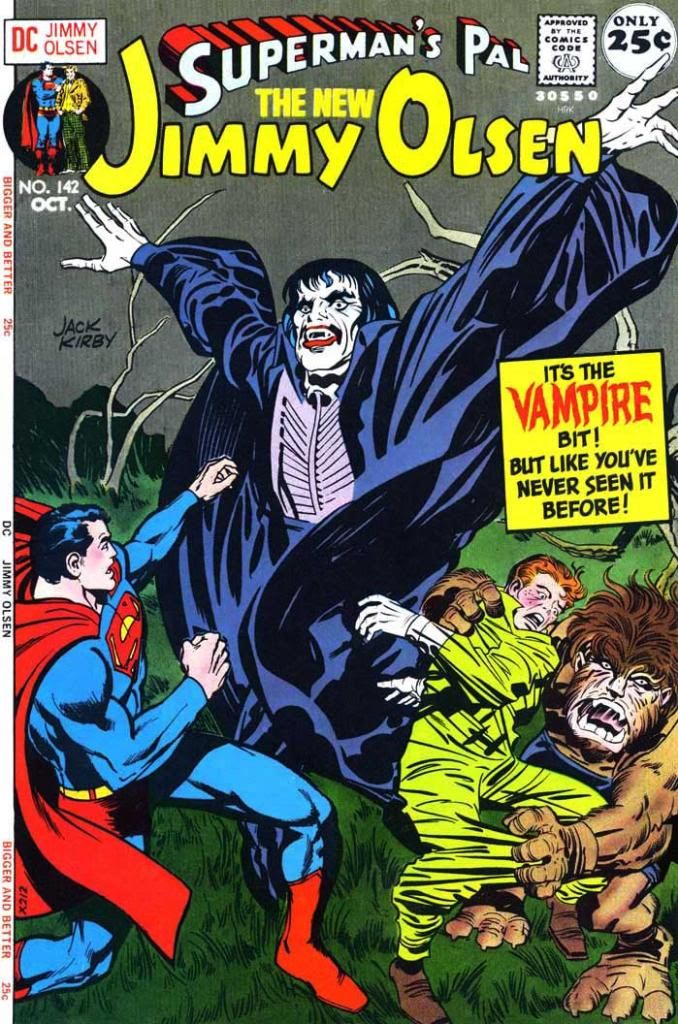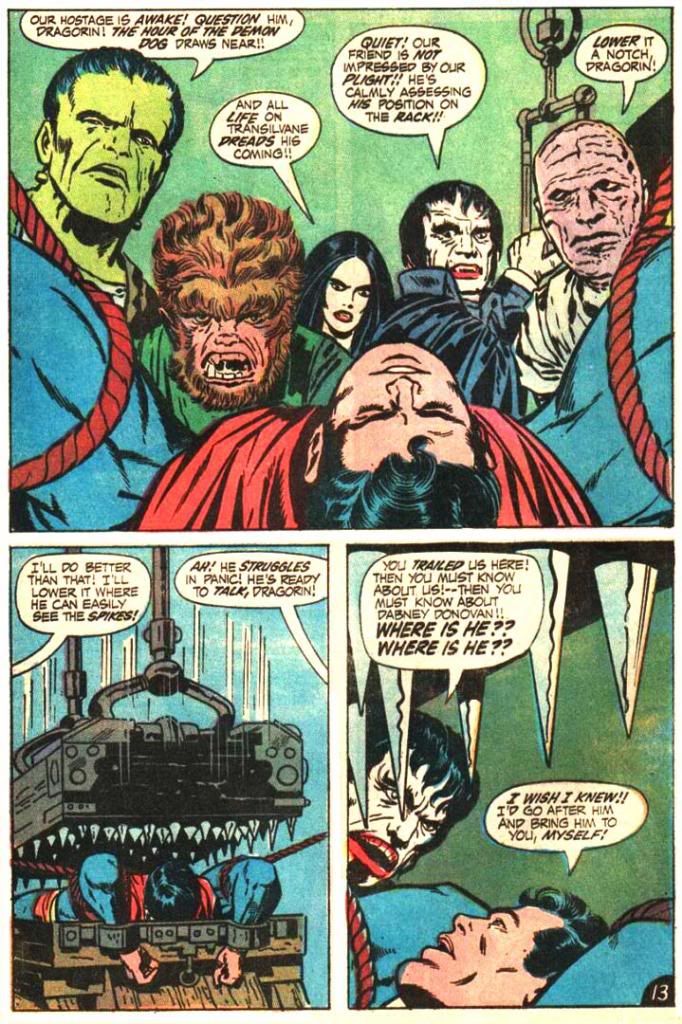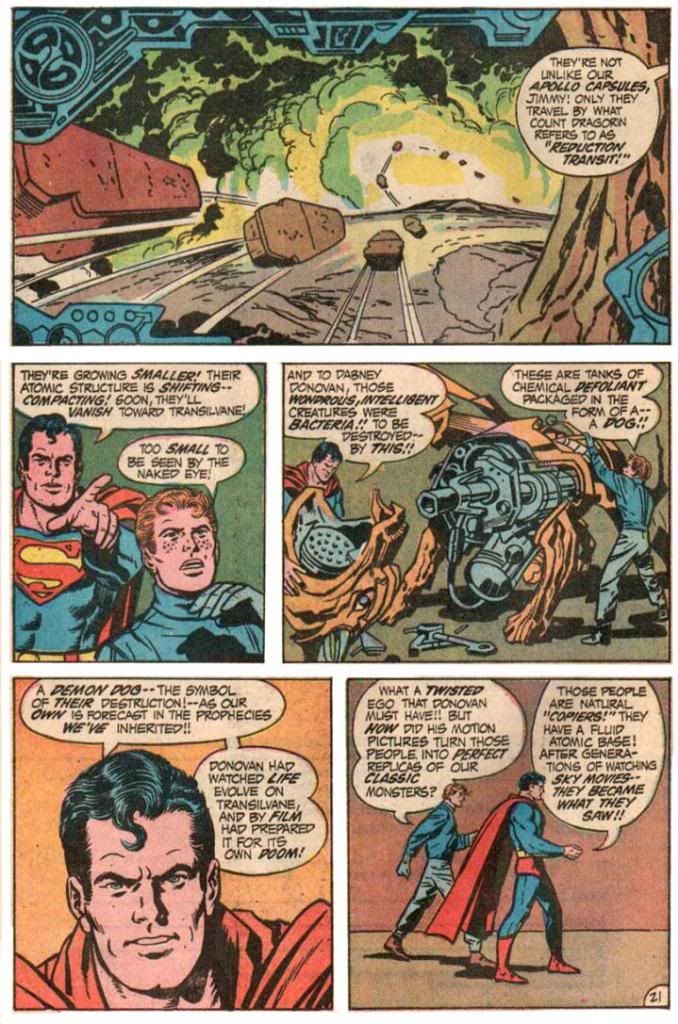Jack Kirby drew comics in just about every genre. Which is a pretty conservative way of putting it when you consider he actually invented or co-invented some of them. As a Kirby fanatic, I wanted to link him to my annual Halloween celebration here, and rather than talk about Spirit World (Kirby does the paranormal) or some of his straight-up horror work (you can find it scattered about in various reprints, Archives, Essentials and Showcases and IDW's Haunted Horror), I have decided to once again explore his early-70s DC years. We love those book here.
In Superman's Pal Jimmy Olsen #142 and #143 (October-November 1971), Kirby gives the then-corny vampire routine a science-fiction/superhero twist. Nowadays we have scary vampires again, and romantic, sparkling vampires and vampires that fight werewolves with Matrix-style kung-fu, but when Kirby wrote this story, movie vampires were pretty much still tuxedo-wearing noblemen and the occasional lesbian baroness in a Victorian-style negligee. Comics in particular had worn out the theme, despite years of a Comics Code ban on vampires. Once EC had modern-day vampires put taps in their victims' necks and Warren saw an old school county-style vampire take a spaceship to a planet of perpetual night, the concept had been stretched past recognition, like Dick Tracy's face imprinted on Silly Putty (I used to love distorting that guy). The only things left were parody and deconstruction. Kirby's story tends towards the latter, although the self-aware cover copy hints at the former.
That's as close to tongue-in-cheek as this story gets. The rest of it is as sincere as Linus' pumpkin patch in It's the Great Pumpkin, Charlie Brown. Kirby expends a lot of energy here trying to make readers buy this concept and he's not playing around or being cutesy.
Count Dragorin, the man from Transilvane, does everything you've come to expect from a vampire, up to and including having a werewolf as a best friend. Kirby wastes no time kickstarting the plot as Dragorin and his beastly companion slip into the city one night and put the bite on a sleeping receptionist by the name of Laura Conway. Kirby's updated answer to the age-old vampiric transformation scene is to have Dragorin accomplish this via some kind of twin yellow power emanations from his eyes. They leave the tradition double bite mark on the receptionist's neck and "change her body chemistry." Within a couple of pages we have Clark Kent and Jimmy Olsen fighting Dragorin for Laura Conway's soul-- or at least her free will-- right there in broad daylight inside the GBS (Galaxy Broadcasting System) offices. Dragorin is after a former NASA scientist named Dabney Donovan, and Conway was once Donovan's personal secretary. Intercut with this is a subplot with the Newsboy Legion trying to escape from the Cadmus Project (they're not prisoners; their fathers work there and they're just up to their usual independent-minded mischief), so these are some really busy issues.
When Superman and Jimmy Olsen track down the scientist's lab (beneath a mausoleum in the pleasantly-named Bloodmoor Cemetery), they find they're not dealing only with a vampire and werewolf couple. There are all kinds of familiar creatures. So what does Kirby do to explain these Space Age vampires, werewolves and the like within the science fiction setting? Well, it turns out Dragorin and company are microscopic aliens from an artificial planet. That floats inside a room that looks like a creepy castle set where James Whale would have put Boris Karloff through his paces, or Todd Browning would have put Bela Lugosi through his. And if that wasn't enough, the aliens on that world have developed a society based on old horror movies as well thanks to the bizarre experiments of Dr. Donovan, who must be a real piece of work himself.
For some reason known but to himself (and, I think, NASA), Donovan didn't just make a world. He also chose those horror movies from his vast personal collection of films and projected them into its clouds. The sentient life there turns out to have remarkable adaptive and imitative properties, kind of like those gangster guys and the Nazis the Star Trek crew dealt with on their old TV show. Some of the people there turned into vampires, some into Frankenstein's monsters and others into mummies and werewolves. They travel from their planet to ours by riding inside coffins that grow or shrink depending on which way they're transiting.
Kirby doesn't really bother to explain Donovan's scientific motivation. After all, what could he have hoped to gain from such an experiment? Certainly if he had published his results, the idea that we as a species could create an entire miniature world full of intelligent, evolving life, would result in a philosophical or even a religious sea change. But Donovan seems to have added these rather baroque flourishes for his own personal enjoyment, and then to destroy via a robotic dog filled with a chemical defoliant.
The horror and science fiction aspects create a dissonance that's fun but, like Frankenstein's monster, reveal some of the stitching Jack Kirby did to make the story work. Because Kirby's trying to assemble this creature in a way that gives it life and makes sense, some of the details are a bit too on-the-nose-- the space coffins compared to the Apollo re-entry process, for example-- while others remain shadowy, as if they're inexplicable. Why did Donovan use old horror movies in the first place? And we not only never meet the nutty scientist who did this, but he never receives a comeuppance for what amounts to attempted genocide.
I love that after all this oversized craziness-- even if it's also about miniature creatures as well-- Kirby chooses to end it on a minor note, with two pals sitting down together to watch Oklahoma! It's just so human. They're not even nonplussed about letting Donovan get away scot free, or having encountered human-created sentient life that could potentially affect life on earth in horrific ways, like some kind of virus escaping from a weapons lab.
But maybe Superman is completely aware of this and downplaying it for Jimmy's sake as he renders the Transilvanians harmless in his own inimitable way. From what I've read, writers and artists later extended the Transilvane concept and finally had Donovan make a story appearance as a full-blown villain, but a true sequel to this story would have Dragorin and friends transformed into good-natured cowboys and farm girls, and singing about a surrey with a fringe on top.
Oh, and be sure to note the Superman figure on the cover to #142. Neal Adams re-touch. And check out all the Al Plastino faces in the interior art. Occasionally some Kirby comes through, but I really wish DC hadn't felt the need to do this.






No comments:
Post a Comment